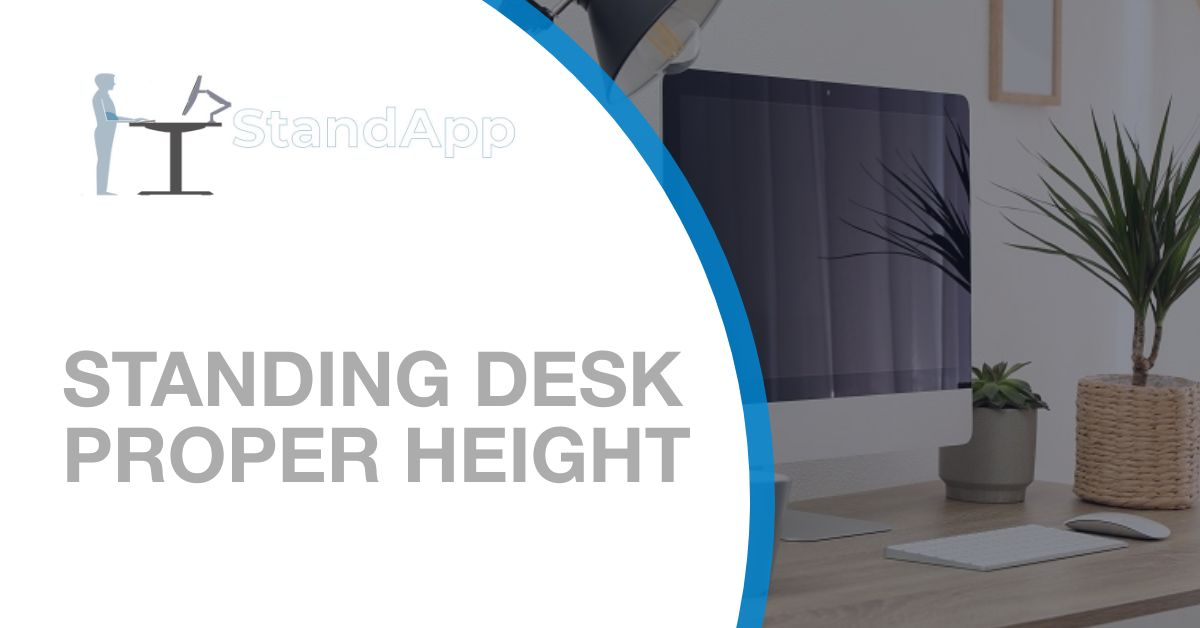
The Proper Height for Standing Desks
Standing desks are becoming more popular in the workplace, but standing for long periods of time is not always comfortable or healthy. If you want to make standing at your desk less painful, then it’s important to know the proper height for standing desks.
The Ideal Desk Height
 Data from a number of sources have been compiled to provide information on what an appropriate height might be, but it’s really going out on a limb when trying to prescribe standards because everyone has their own body mechanics and personal preference as far as comfort levels go with sitting at work desks all day long. That being said though – here are some general guidelines:
Data from a number of sources have been compiled to provide information on what an appropriate height might be, but it’s really going out on a limb when trying to prescribe standards because everyone has their own body mechanics and personal preference as far as comfort levels go with sitting at work desks all day long. That being said though – here are some general guidelines:
- Your ideal standing desk height is the only one that works for you.
- The average person stands around six hours per day while they’re engaged in other tasks besides typing away at keyboards or using laptops; thus if we assume our users put themselves up forty eight times throughout any given week then they’ll need roughly 14 inches off ground clearance during those periods where self-standing is preferred.
- The first thing to consider is that standing desks should be tall enough so that the user has somewhere to prop their feet and legs; this can vary from person-to-person, but we suggest at least eleven inches of clearance underneath which allows for a good solid position for standing with one’s feet flat on the floor where they can be braced with standing shoes.
- The standing desk height is going to be most effective when it’s used in conjunction with a good ergonomic chair that has adjustable lumbar support and can rotate freely on swivel casters so the user doesn’t have to stand constantly at their standing desks, but rather take breaks from standing while still being engaged in productive tasks.
- Each standing desk height should be adjusted to the individual; standing desks that are too low will cause discomfort and fatigue, standing desks that are too high can lead to a feeling of vertigo or even disorientation depending on how long one spends working at them when they finally do get up from their standing desks.
- Most standing desks are adjustable in order to accommodate users of differing heights, but it’s possible to find standing desks that only come in a single size suitable for people who are average height or taller; these types of standing desks will work fine so long as your body mechanics allow you to stand comfortably at standing desks for a period of time.
- Standing desks are not recommended for people over six feet tall. If you’re a tall person, it’s best not to use standing desks. They can cause back problems and other health issues by making people adjust their posture in order remain comfortable while at the same time stand all day long.
- Do not place your monitor too high or too low, as this will cause neck strain. Make sure you adjust your monitor to the right height. If it’s too high, then craning your neck can cause discomfort after long periods of time use; if its set too low then fatigue will quickly set in as well.
- A standing desk should have enough space so that you can always work with comfort, without feeling cramped or uncomfortable.
- When choosing a standing desk, be sure to check its adjustable height range. A good rule of thumb is that you should buy one at least three inches shorter than your current height so it will have enough space when being used without feeling too high or low for sitting in front on an keyboard all day long.
- Working from a standing desk all day long is exhausting and can make your feet hurt. A foot rest will help alleviate some of the pain by providing you with extra support while working or just resting!
So what is the best height for a standing desk?

The answer depends on your needs and preferences. If you’re looking to lower your risk of injury, we suggest starting with a 20-inch high stand up desk.
For those who want to maximize their productivity by staying in motion at all times, try 30 inches or higher so that you can maintain an upright posture while working.
However, if you have back issues such as degenerative disc disease, arthritis, scoliosis or sciatica consider going even taller than 36 inches because it will allow more space between your torso and hips which may help take pressure off of painful areas when sitting down.
A standing desk with adjustable height range is going to be much more useful for the average standing desk user.
For those that prefer standing desks over sitting all day long, but want something adjustable so they can take breaks from standing up at their standing desks, invest in an adjustable height standup desk with rollers on it because you’ll need the ability to adjust standing desk height with ease.



